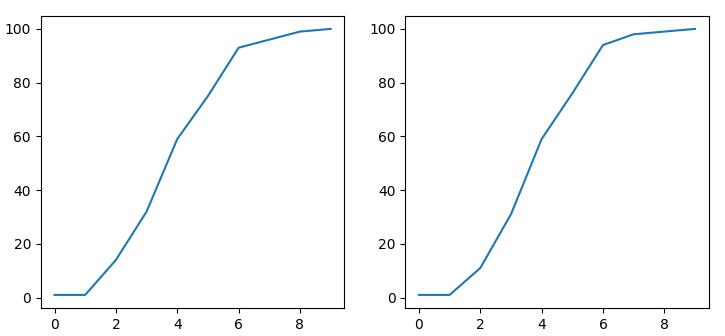Python处理PDF与CDF Python处理PDF与CDF实例
Apple@Jing 人气:1在拿到数据后,最需要做的工作之一就是查看一下自己的数据分布情况。而针对数据的分布,又包括pdf和cdf两类。
下面介绍使用python生成pdf的方法:
使用matplotlib的画图接口hist(),直接画出pdf分布;
使用numpy的数据处理函数histogram(),可以生成pdf分布数据,方便进行后续的数据处理,比如进一步生成cdf;
使用seaborn的distplot(),好处是可以进行pdf分布的拟合,查看自己数据的分布类型;

上图所示为采用3种算法生成的pdf图。下面是源代码。
from scipy import stats import matplotlib.pyplot as plt import numpy as np import seaborn as sns arr = np.random.normal(size=100) # plot histogram plt.subplot(221) plt.hist(arr) # obtain histogram data plt.subplot(222) hist, bin_edges = np.histogram(arr) plt.plot(hist) # fit histogram curve plt.subplot(223) sns.distplot(arr, kde=False, fit=stats.gamma, rug=True) plt.show()
下面介绍使用python生成cdf的方法:
使用numpy的数据处理函数histogram(),生成pdf分布数据,进一步生成cdf;
使用seaborn的cumfreq(),直接画出cdf;

上图所示为采用2种算法生成的cdf图。下面是源代码。
from scipy import stats import matplotlib.pyplot as plt import numpy as np import seaborn as sns arr = np.random.normal(size=100) plt.subplot(121) hist, bin_edges = np.histogram(arr) cdf = np.cumsum(hist) plt.plot(cdf) plt.subplot(122) cdf = stats.cumfreq(arr) plt.plot(cdf[0]) plt.show()
在更多时候,需要把pdf和cdf放在一起,可以更好的显示数据分布。这个实现需要把pdf和cdf分别进行归一化。

上图所示为归一化的pdf和cdf。下面是源代码。
from scipy import stats import matplotlib.pyplot as plt import numpy as np import seaborn as sns arr = np.random.normal(size=100) hist, bin_edges = np.histogram(arr) width = (bin_edges[1] - bin_edges[0]) * 0.8 plt.bar(bin_edges[1:], hist/max(hist), width=width, color='#5B9BD5') cdf = np.cumsum(hist/sum(hist)) plt.plot(bin_edges[1:], cdf, '-*', color='#ED7D31') plt.xlim([-2, 2]) plt.ylim([0, 1]) plt.grid() plt.show()
以上这篇Python处理PDF与CDF实例就是小编分享给大家的全部内容了,希望能给大家一个参考,也希望大家多多支持。
加载全部内容